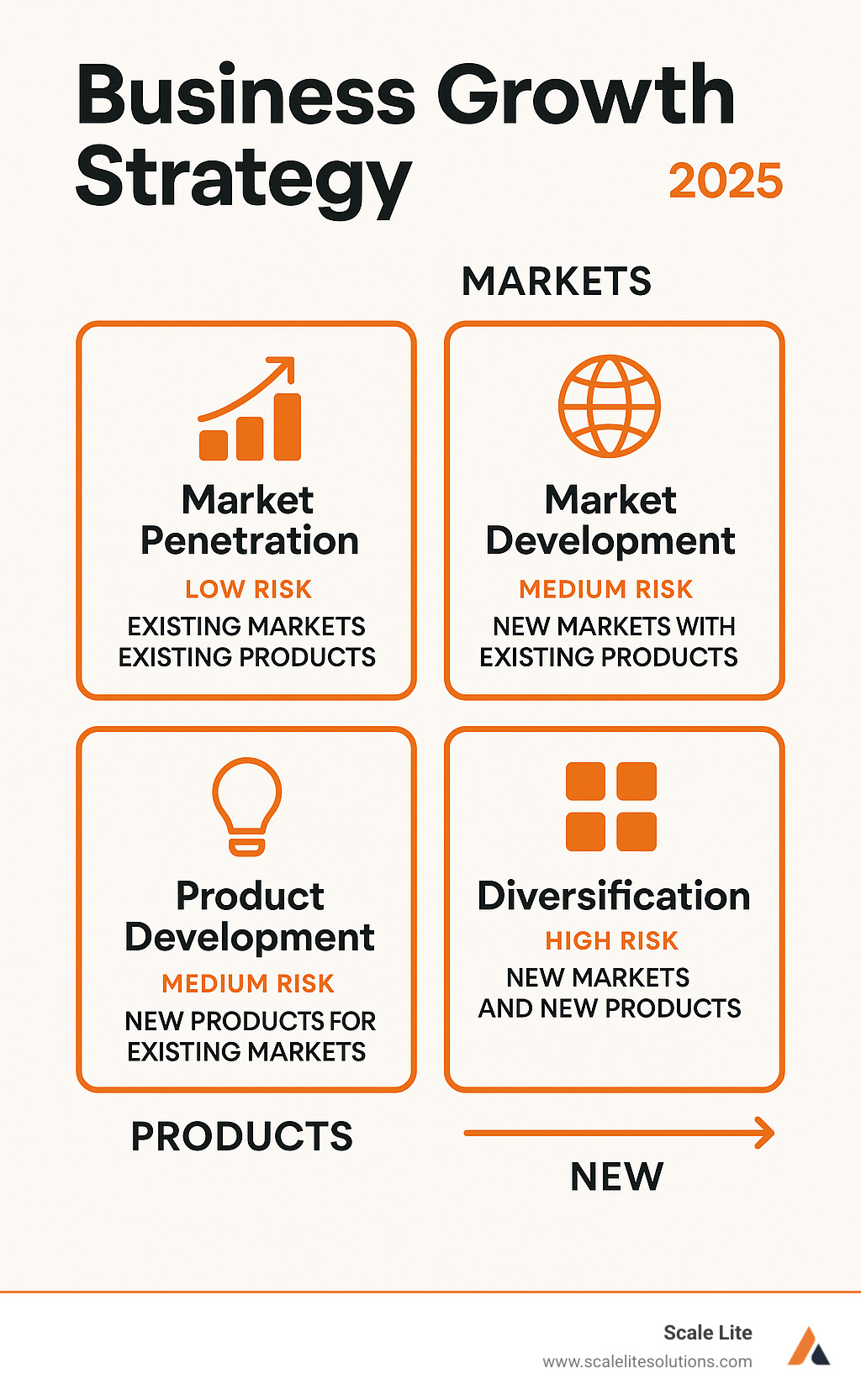
Grow Big or Go Home – Proven Strategies for Business Expansion

Why Business Growth Strategy is Your Blueprint for Success
Business growth strategy is a comprehensive plan that outlines how your company will expand its market share, increase revenue, and build long-term value. Here are the key types every business owner should know:
Core Growth Strategies:
- Market Penetration - Sell more to existing customers in your current market
- Market Development - Take current products to new markets or customer segments
- Product Development - Create new products for your existing customers
- Diversification - Enter new markets with new products (highest risk, highest reward)
Modern Growth Approaches:
- Strategic Partnerships - Team up with complementary businesses
- Digital Change - Use technology and automation to scale operations
- Organic Growth - Improve internal processes and efficiency
The numbers don't lie - only 25% of companies grow sustainably over time, but businesses with a documented growth plan are 30% more likely to succeed. Without a strategic approach, you're leaving growth to chance in an increasingly competitive marketplace.
Most blue-collar business owners I work with are profitable but stuck. They've built great companies through hard work and relationships, but they hit a wall when trying to scale beyond their personal involvement. The difference between businesses that plateau and those that thrive comes down to having a clear, actionable growth strategy.
I'm Keaton Kay, and I've spent years helping service businesses develop and execute business growth strategy through my work in private equity, enterprise sales, and now as founder of Scale Lite. I've seen how the right strategic approach can transform owner-dependent operations into scalable, valuable companies.

Core Business Growth Strategies: 4 Proven Models for Expansion
When it comes to business growth strategy, you don't need to reinvent the wheel. The Ansoff Matrix, developed by strategic planning pioneer Igor Ansoff, gives us a clear framework for understanding your options. Think of it as your GPS for growth - it shows you four main routes based on whether you're working with existing or new products and markets.
What makes this framework so valuable is how it maps risk against reward. The further you venture from your comfort zone (existing products and markets), the higher the risk - but also the greater the potential payoff.
| Strategy | Risk Level | Target Market | Product/Service |
|---|---|---|---|
| Market Penetration | Low | Existing | Existing |
| Market Development | Medium | New | Existing |
| Product Development | Medium | Existing | New |
| Diversification | High | New | New |
Market Penetration: A Foundational Business Growth Strategy
Market penetration is where most smart businesses start their growth journey. It's about getting more from what you already have - selling more of your current services to your existing market. Think of it as mining deeper in a proven goldmine rather than searching for new deposits.
This strategy focuses on increasing market share through better customer loyalty, competitive pricing, and improving customer service. For service businesses, this might mean perfecting your local SEO, streamlining your sales process, or simply being the most reliable option in your area.
Here's why this approach makes financial sense: it costs five times more to get a new customer than to keep a current one. When you focus on existing customers and deepen those relationships, you're building on a foundation that's already proven to work.
Look at Coca-Cola's success with this strategy. Their 42.8% market share in the carbonated beverage market didn't happen overnight. It's the result of decades of market penetration efforts - making sure their product is everywhere and always top of mind.
For service businesses, mastering market penetration often involves refining operational efficiency, enhancing customer experience, and using data to understand exactly what your current customers want more of. To learn more about how data can drive your strategy, explore our insights on Data-Driven Business Strategy.
Market Development: Conquering New Territories
Once you've squeezed the most juice from your current market, market development becomes your next logical step. This strategy takes your existing products or services and introduces them to new markets or customer segments. You're essentially finding new ponds for your fish.
Geographic expansion is one popular approach - opening new branches in different cities or states. The appetite for this strategy is strong: in a 2023 survey reported by Forbes, 79% of business owners focused on expanding into new geographies. This shows just how many companies see territorial growth as their path forward.
But geography isn't your only option. You might target new customer segments with your existing offerings. A commercial cleaning service could start serving residential clients, or a B2B contractor might explore consumer markets. You could also explore new distribution channels - selling through online platforms, wholesale, or partnerships that reach fresh audiences.
Market development carries more risk than penetration because you're venturing into unknown territory. But the potential rewards are also higher. Success requires thorough market research to understand the needs and competitive landscape of these new markets. Our focus on scalable service operations helps businesses prepare for this kind of expansion, ensuring they have the infrastructure to support growth without breaking. You can find more insights on how to prepare for this growth in our guide on Scalable Service Operations.
Product Development: Innovating for Your Loyal Customers
Product development flips the script - instead of finding new customers, you create new products or services for your existing markets. It's about giving your loyal customers more reasons to stick with you and spend more money with your business.
This strategy hinges on understanding your customers' evolving needs and investing in research and development. You might improve existing services by adding new features or improving quality. You could create entirely new offerings that complement what you already do. Or you might bundle services in new ways to create added value.
Apple is the master of this approach. They constantly release new versions of their devices and services, primarily aimed at their existing, fiercely loyal customer base. In 2024, Apple spent over $31 billion on R&D - a testament to their commitment to this strategy. This continuous innovation keeps their customers engaged and coming back for more.
For blue-collar service businesses, product development might look like adding specialized services, offering maintenance contracts, or developing proprietary tools or methods. It's about expanding your value proposition to the customers who already trust you. Our expertise in growth marketing helps businesses effectively launch and promote these new offerings to their existing audience. Explore more about how we approach Growth Marketing.
Diversification: Venturing into the Unknown
Diversification is the boldest move in your business growth strategy playbook. This involves introducing new products or services into entirely new markets - essentially launching a whole new business under your existing brand. It's high risk, high reward territory.
You can approach diversification in different ways. Related diversification means moving into new products and markets that have some strategic fit with your current operations. Think of a commercial cleaning company starting a janitorial supply business - different product, different market, but there's logical overlap.
Unrelated diversification is the highest risk approach - venturing into completely new industries with no obvious connection to your current business. Our research includes an example of a construction equipment company creating a new line of consumer snowmobiles. While seemingly unrelated, they might have leveraged manufacturing expertise or distribution channels.
The main benefit of diversification is reducing market dependency. When you're not putting all your eggs in one basket, you spread risk and open up vast new avenues for growth. However, it requires significant investment, new expertise, and a high tolerance for uncertainty.
This strategy works best when you have strong cash flow from your core business and the management bandwidth to handle complexity. It's about expanding business scope while maintaining excellence in your original market.
Beyond the Matrix: Modern Strategies for a Competitive Edge
The Ansoff Matrix gives us a solid foundation, but today's business world moves faster than ever. Success isn't just about what you sell or where you sell it anymore - it's about how you operate, who you partner with, and how you leverage technology to stay ahead of the competition.
Think of these modern strategies as power-ups for your traditional growth approaches. They work beautifully alongside the core matrix strategies, often amplifying their effectiveness. A business growth strategy that combines these contemporary approaches with the classic models creates a competitive advantage that's hard to beat.
Strategic Alliances: Growing Stronger, Together
There's truth in the old saying that two heads are better than one. Strategic alliances let you tap into someone else's strengths while sharing your own. Instead of building everything from scratch, you're leveraging what already exists - and that's smart business.
These partnerships can take many forms. You might collaborate on large projects that neither business could handle alone, or engage in cross-promotion with complementary services. Think about a landscaping company teaming up with a pool maintenance service - their customers naturally overlap, and both businesses benefit from the referrals.
More ambitious alliances involve mergers and acquisitions, though these require careful planning. The goal is always to leverage complementary strengths and access new customer bases without starting from zero.
A perfect example is the partnership between Fenty Beauty and Ulta Beauty at Target. This strategic alliance allowed Fenty Beauty to significantly expand its retail footprint, reaching customers through an established, trusted retailer. For service businesses, this might mean partnering with general contractors, property management companies, or local suppliers to broaden your reach and referral network.
Digital Change: Leveraging Technology for Growth
Here's where the rubber meets the road for modern growth. Digital change isn't just about having a website anymore - it's about adopting new technologies, automating workflows, and using data analytics to create genuine competitive advantages.
For many blue-collar service businesses, this represents the biggest untapped opportunity. We're talking about workflow automation that handles scheduling, invoicing, and customer communication automatically. AI deployment can optimize routing, predict maintenance needs, or handle routine customer inquiries. Data analytics helps you understand what's working, what isn't, and where your next opportunity lies.
The beauty of technology is that it doesn't just make you more efficient - it improves operational efficiency while creating competitive advantages that are hard for others to copy. When you can respond faster, deliver more consistently, and predict problems before they happen, you're not just competing on price anymore.
This is exactly the kind of change we help businesses achieve at Scale Lite. To see practical examples of how digital change can benefit your specific situation, check out our guide on Digital Change Examples for Small Business.
Organic Growth: Strengthening From Within
Sometimes the best growth strategy is looking inward. Organic growth focuses on strengthening internal resources, optimizing processes, and improving efficiency with what you already have. It's about building a stronger foundation before you try to build higher.
This approach involves reinvesting profits back into your operations, whether that's upgrading equipment, training employees, or streamlining workflows. Content marketing and SEO play a huge role here too - creating valuable content that naturally attracts customers through search engines.
Here's a compelling statistic: according to Zapier, 72% of their organic traffic came from SEO-focused blogs. That's the power of providing genuine value and being findable online. It's not flashy, but it works consistently over time.
The key to organic growth is process optimization - making your internal engine run smoother and more efficiently. When you can deliver better service at lower cost, growth becomes a natural byproduct. Our expertise in business process streamlining helps companies achieve exactly this kind of internal strength. Learn more about Business Process Streamlining.
How to Develop and Implement a Winning Growth Plan
Having a brilliant business growth strategy on paper means nothing if you can't execute it. The difference between businesses that thrive and those that struggle often comes down to one thing: turning strategic ideas into concrete action. Here's the reality - new business ventures are 260% more likely to launch when they have a business plan, and they're 30% more likely to grow when they have a documented strategy to follow.
Think of your growth plan as your GPS for business success. You wouldn't start a road trip without knowing where you're going, and you shouldn't try to grow your business without a clear, step-by-step roadmap.

Step 1: Conduct In-Depth Research
Before you make any big moves, you need to understand the playing field. This isn't about drowning in data - it's about gathering the right information to make smart decisions.
Market analysis is your starting point. You need to know how big your target market is, where it's heading, and what your customers actually want. What keeps them up at night? What problems are they trying to solve? Understanding these pain points helps you position your services as the solution they've been looking for.
Competitor research comes next, but here's the thing - your competitors aren't your enemies. They're your teachers. Study what they're doing well and where they're falling short. Are they missing opportunities you could capitalize on? Are they serving customers in ways you hadn't considered?
The SWOT analysis - looking at your Strengths, Weaknesses, Opportunities, and Threats - ties everything together. This gives you a honest, 360-degree view of where you stand and where you could go. Maybe your strength is incredible customer service, but your weakness is outdated scheduling systems. That's valuable information for planning your next moves.
This research isn't a one-and-done activity. Markets change, customers evolve, and new competitors emerge. Make research an ongoing part of your business routine.
Step 2: Set SMART Goals
Once you understand your landscape, it's time to decide where you want to go. Vague goals like "grow the business" or "make more money" won't cut it. You need SMART goals that give you clear targets to aim for.
Specific means getting crystal clear about what you want to achieve. Instead of "increase revenue," try "increase monthly recurring revenue from maintenance contracts by 25%." Measurable means you can track your progress with real numbers. Achievable keeps you realistic - ambitious is good, but impossible is just frustrating. Relevant ensures your goals actually matter to your business vision. Time-bound gives you a deadline to work toward.
These goals become your Key Performance Indicators (KPIs) - the metrics that tell you whether your business growth strategy is working. Without clear goals, you're just spinning your wheels and hoping for the best.
Step 3: Create Your Action Plan: The Heart of Your Business Growth Strategy
This is where the rubber meets the road. Your action plan transforms your strategic vision into specific tasks that real people can actually do. It's your detailed roadmap that assigns responsibilities, sets deadlines, and allocates the resources you need to succeed.
For every strategic initiative, you need to nail down the specifics. What exactly needs to be done? Break big goals into smaller, manageable tasks. Who's responsible for each piece? Clear accountability prevents things from falling through the cracks. When does each task need to be completed? Deadlines create urgency and keep momentum going. What resources do you need? Whether it's budget, tools, technology, or additional team members, plan for what success requires.
This detailed planning ensures everyone in your organization understands their role in achieving your growth objectives. It creates accountability and keeps everyone moving in the same direction. We've seen time and again that businesses with clear action plans are the ones that actually achieve their growth targets. For more insights on turning strategy into results, check out our guide on How to Drive Business Growth.
Step 4: Measure, Analyze, and Adapt
Here's where many businesses stumble - they create a plan and then forget about it. A successful business growth strategy requires constant attention and adjustment. The market doesn't stand still, and neither should your strategy.
Regular reviews keep you on track. Schedule monthly or quarterly check-ins to assess your progress against those SMART goals you set. Are you hitting your targets? If not, why not? These reviews help you spot problems early and celebrate wins along the way.
Data analysis turns numbers into insights. Your sales figures, customer feedback, marketing results, and operational metrics all tell a story. The key is learning to read that story and understand what it means for your business.
Agility and adaptation separate successful businesses from the rest. When something isn't working, don't stick with it out of stubbornness. Learn from what went wrong, adjust your approach, and try again. According to McKinsey research, organizational changes that get the full team involved are eight times more likely to succeed. This means your entire team should be part of the measurement and adaptation process.
The businesses that thrive are the ones that treat their growth strategy as a living document - constantly evolving based on real-world feedback and results. Our approach emphasizes data-driven decision-making to ensure your growth efforts are always optimized for success. Learn more about this approach in our resource on Data-Driven Decision Making.
Frequently Asked Questions about Business Growth Strategies
What are the most common types of business growth strategies?
When business owners ask me about growth strategies, I always start with the fundamentals. The four most common business growth strategies come from the Ansoff Matrix we discussed earlier: Market Penetration, Market Development, Product Development, and Diversification. These form the foundation of strategic thinking about expansion.
But here's the thing - the business world has evolved beyond these classic models. Today's most successful companies also leverage strategic partnerships to accelerate growth, accept digital change through technology and automation, and focus heavily on organic growth through internal improvements like process optimization and content marketing.
The beauty of these strategies is that they're not mutually exclusive. You can think of them as tools in your growth toolkit, each serving different purposes depending on your situation and goals.
How do I choose the right growth strategy for my business?
This is probably the most important question, and honestly, there's no one-size-fits-all answer. The right business growth strategy depends on several key factors: your industry, current market position, available resources, and - perhaps most importantly - your tolerance for risk.
I always recommend starting with a thorough SWOT analysis (Strengths, Weaknesses, Opportunities, Threats). This gives you a clear picture of your internal capabilities and external landscape. Think of it as taking inventory before you decide which direction to head.
Here's a simple way to think about risk levels: Market Penetration (selling more of your current services to existing customers) is like improving your current recipe - low risk, steady results. On the other end, Diversification (new services for completely new markets) is like opening a restaurant in a foreign country where you don't speak the language - high risk, but potentially huge rewards.
Consider your existing assets too. Do you have strong customer relationships? That might point toward Product Development. Great operational systems? Maybe Market Development is your path. The key is building on what you already do well.
Can a business use multiple growth strategies at once?
Absolutely, and I actually recommend it! The most successful companies I work with don't put all their eggs in one basket. They're constantly working on multiple fronts.
For example, a commercial cleaning company might pursue Market Penetration by improving their sales process and customer retention programs while simultaneously engaging in Product Development by adding specialized services like deep cleaning or maintenance contracts. They might even explore Market Development by expanding into residential cleaning.
The most effective approach combines organic growth (improving internal efficiency and operations) with strategic growth initiatives (like entering new markets or forming partnerships). Research shows that businesses growing in multiple directions over a ten-year period have double the chance of outperforming their peers.
The secret is balance. You want to maintain stability through your core business while strategically expanding into new opportunities. It's like tending a garden - you keep nurturing your existing plants while carefully planting new seeds for future harvests.
Just remember: while multiple strategies can accelerate growth, they also require more resources and attention. Make sure you have the bandwidth to execute well rather than spreading yourself too thin.
Conclusion: Your Next Move Towards Scalable Growth
We've journeyed through the essential landscape of business growth strategy, from the time-tested Ansoff Matrix approaches like Market Penetration and Diversification to today's cutting-edge methods including Strategic Alliances, Digital Change, and Organic Growth. The golden thread connecting all these strategies is clear: sustainable growth demands a planned, data-driven approach.
Here's the truth that many business owners learn the hard way - sustainable growth isn't a finish line you cross once and celebrate forever. It's an ongoing journey of planning, execution, measurement, and adaptation. The businesses that thrive are those that treat growth as a continuous process, not a one-time event.
For service businesses in traditional industries, this journey often starts with a simple but powerful step: modernizing operations and leveraging technology strategically. I've seen countless blue-collar businesses transform from owner-dependent operations into scalable, valuable companies simply by embracing the right technological tools and systematic approaches.
At Scale Lite Solutions, we've built our entire approach around this reality. We provide a holistic approach to growth, integrating tech and automation to build scalable, valuable businesses. Our comprehensive services include AI deployment, workflow automation, data gathering through appropriate technology configuration, and CRM optimization - all designed to improve operational efficiency and drive sustainable growth.
The goal isn't just to help you grow bigger; it's to help you maximize the value of your business while creating systems that work without your constant involvement. When you combine strategic thinking with modern technology, you create something powerful: a business that can scale efficiently and sustainably.
Ready to transform your operations and open up new levels of growth? Find how the right technological approach can revolutionize your business operations and help you build something truly scalable. Learn how Automation & AI can transform your business.








